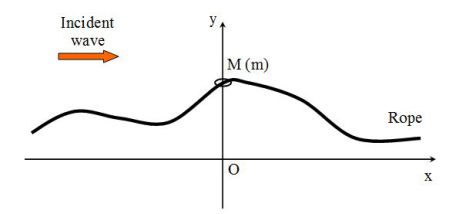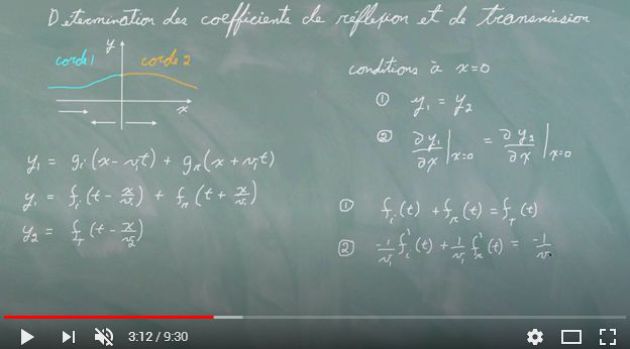Reflection on a free mass
Take 15 minutes to prepare this exercise.
Then, if you lack ideas to begin, look at the given clue and start searching for the solution.
A detailed solution is then proposed to you.
If you have more questions, feel free to ask them on the forum.
At point of abscissa \(x=0\) of a very long rope, linear density \(\mu\), a mass \(m\) is attached on the rope.
An incident wave :
\(\underline y_{\;i}(x,t)=ae^{i(\omega t - kx)}\)
arrives from the side \(x<0\).

Question
Determine the expression of the reflection coefficient \(\underline r\) (neglecting the weight of the mass).
What will happen if \(m\) becomes very large ?
Indice
What are the boundary conditions in \(x=0\) ?
Apply Newton's second law to the mass \(m\)
Solution
The incident wave gives rise to a reflected wave :
\(\underline y_r(x,t)=\underline r \;ae^{i(\omega t + kx)}\)
And transmitted wave :
\(\underline y_t(x,t)=\underline t \;ae^{i(\omega t - kx)}\)
Where \(\underline r\) and \(\underline t\) are the complex coefficients of reflection and transmission.
The continuity of the position of the mass \(m\) in \(x=0\) gives the first equation :
\(1+\underline r = \underline t\)
The second law of Newton, applied to the mass \(m\) (and neglecting the weight of the mass), is written (see figure) :
\(m\frac {dv(0,t)}{dt} \vec u_y=\vec T(0^+,t)-\vec T(0^-,t)\)
Where the speed \(v(0,t)\) of the mass \(m\) can be expressed as :
\(v(0,t)=(\frac{\partial \underline y_t(x,t)}{\partial t})_{x=0^+}=(i\omega) \underline t \;a e^{i \omega t}\)
And \(\vec T(0^+,t)\) and \(\vec T(0^-,t)\) denote the tension forces from the rope on both sides of the mass \(m\).

In projection along the (Ox) axis, we obtained (see figure to the definition of angles \(\alpha(0^+,t)\) and \(\alpha(0^-,t)\)) :
\(T(0^+,t)cos(\alpha (0^+,t)-T(0^-,t)cos(\alpha (0^-,t)=0\)
The angles being small, the cosine is equal to \(1\). Thus :
\(T(0^+,t)=T(0^-,t)=cste=T_0\)
The magnitude of tension is a constant \(T_0\).
In projection along the (Oy) axis, and assimilating the sines to the values of the angles expressed in radians :
\(-m\omega ^2 \underline t \;a e^{i \omega t}=T_0 (\alpha(0^+,t)-\alpha(0^-,t))\)
Yet :
\(\alpha(0^+,t)=(\frac{\partial y_t(x,t)}{\partial x})_{x=0^+}\;\) and \(\;\alpha(0^-,t)=(\frac{\partial (y_i(x,t)+y_r(x,t))}{\partial x})_{x=0^-}\)
And :
\(\alpha(0^+,t)=-ika \underline t\; e^{i\omega t}\;\) and \(\; \alpha(0^-,t)=ika(1-\underline r)\;e^{i\omega t}\)
That is to say :
\(-m \omega ^2 \underline t =-i kT_0\underline t+ikT_0( 1-\underline r)\)
Finally obtained the following system of two equations :
\(\left\{ \begin{array}{l}1 +\underline r=\underline t \\- m{\omega ^2}\underline t= ik{T_0}( -\underline t+ 1 -\underline r) \\\end{array} \right.\)
With :
\(k=\frac{\omega}{c}=\omega \sqrt {\frac{\mu}{T_0}}\)
The resolution gives :
\(\underline r =-\frac {1}{1-2i \frac{\sqrt {\mu T_0}}{m\omega}}\)
For a very large mass (\(m>>\sqrt{\mu T_0}/\omega\)), the reflection coefficient approaches \(-1\) : there is total reflection in the opposite phase and without transmitted wave (transmission coefficient approaches \(0\)).
The inertia of the mass blocks the passage of the incident wave with creation of a standing wave for \(x<0\).
